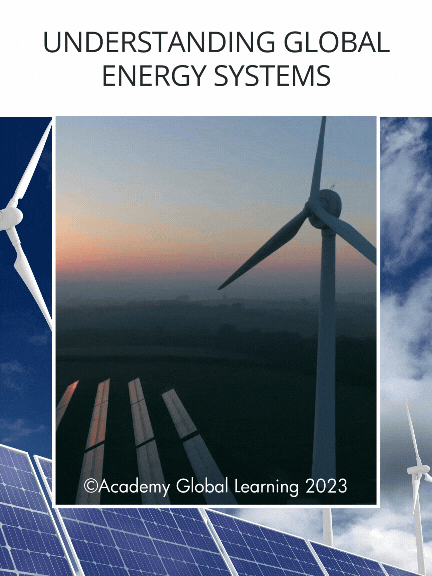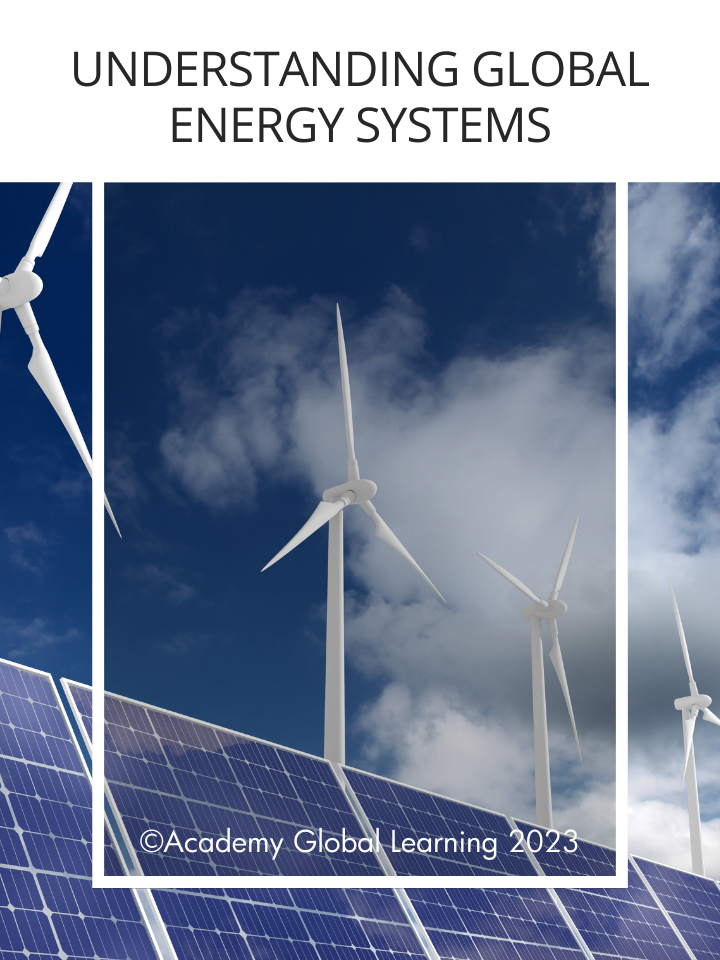

This book developed by ©Academy Global Learning 2024
All rights reserved under ©Academy Global Learning 2024. No part of this publication may be reproduced, stored in a retrieval system, or transmitted in any form or by any means, electronic, mechanical, photocopying, recording, or otherwise, without the prior written permission of the copyright owner.
Designed By:
Christian Alas
Created and illustrated By:
Angelo Romero

Chapter 1: Understanding Global Energy Systems
Introduction
Welcome to Lesson 1: Understanding Global Energy Systems. As emerging leaders in the energy sector, you are stepping into a world of immense challenges and opportunities. Energy is the engine that drives global economies, powers our homes, and fuels innovation. Yet, the global energy landscape is complex and continuously evolving, with far-reaching implications for environmental sustainability, international relations, and economic growth.
This chapter will guide you through the essential concepts of global energy flows, the diversity of energy resources, and the production and consumption patterns that influence our world. By understanding these foundational elements, you will be better equipped to make strategic, forward-thinking decisions that drive positive change. Remember, your leadership will shape the future of energy, and the knowledge you gain today will empower you to lead effectively tomorrow.
– 2 –
Global Energy Flow
Energy flow refers to the movement and transformation of energy from production to consumption. It encompasses energy infrastructure, such as power plants, oil refineries, and smart grids, which are digitally enhanced electricity networks that optimize energy distribution. Understanding these systems is crucial for developing innovative strategies that promote energy efficiency, which means using less energy to perform the same tasks, thus reducing waste and conserving resources.
Overview of Global Energy Flow by Country
To understand global energy leadership, it’s essential to explore how different countries manage and distribute energy:
United States: The U.S. has a diverse energy portfolio, with significant investments in oil, natural gas, and renewables. The country’s energy infrastructure is vast and complex, including advanced smart grids that enhance reliability and prevent power outages. However, balancing fossil fuel reliance with clean energy targets remains a major challenge, especially as energy demand continues to grow.
– 3 –
Germany: Known for its ambitious Energiewende (energy transition), Germany is a global leader in renewable energy. The nation aims to achieve 100% renewable electricity by 2050, integrating sources like solar and wind into a smart grid system that maximizes efficiency. However, the country’s decision to phase out nuclear energy has raised concerns about energy security, which refers to the uninterrupted availability of energy at affordable prices.
China: As the world’s largest energy consumer and carbon emitter, China’s energy landscape is dominated by coal. Despite this, the nation is making significant strides in renewable energy, becoming a leader in solar and wind power. The government’s heavy investment in clean energy technologies is part of a broader strategy to reduce the country’s carbon footprint—the total greenhouse gas emissions produced by human activities.
Saudi Arabia: A powerhouse in oil production, Saudi Arabia’s energy system is heavily oil-dependent. However, the country’s Vision 2030 plan seeks to diversify its energy mix by investing in solar energy and other renewables. The goal is to achieve energy independence, reducing reliance on foreign energy imports and enhancing national security.
– 4 –
Brazil: With abundant natural resources, Brazil relies heavily on hydropower, which accounts for a large portion of its electricity generation. Hydropower is a renewable energy source that uses the flow of water to generate electricity, but large dam projects can have significant environmental and social impacts, including the displacement of communities and disruption of ecosystems.
India: As a rapidly growing economy, India’s energy needs are immense. The country remains dependent on coal but is expanding its renewable energy capacity, particularly in solar energy. India’s ambitious goals include reaching 500 gigawatts (GW) of non-fossil fuel energy by 2030.
Norway: Almost all of Norway’s electricity comes from hydropower, making it one of the most sustainable energy producers globally. However, as a major oil and gas exporter, Norway faces a paradox: maintaining a low carbon footprint domestically while exporting fossil fuels that contribute to global emissions.

– 5 –
Australia: Known for its vast reserves of coal and natural gas, Australia is also investing in large-scale solar and wind projects. The country’s energy transition is driven by the need to reduce carbon emissions while leveraging its abundant renewable resources.
These examples illustrate the interconnected nature of global energy systems, where decisions made in one country can have ripple effects worldwide.
Energy Resource Breakdown
Energy resources can be divided into two main categories: non-renewable and renewable. Each has unique advantages, challenges, and environmental impacts that future leaders must understand to make informed decisions.

– 6 –
Non-Renewable Energy Sources
Non-renewable resources, such as coal, oil, and natural gas, have been the backbone of industrial development but are also major contributors to climate change.
1. Coal: Historically, coal has been a crucial energy source for electricity generation. However, it is a significant source of carbon emissions, which contribute to global warming. Example: China, the largest consumer of coal, depends on it for 57.7% of its energy needs, creating immense environmental and public health challenges.
2. Oil: Essential for transportation and industry, oil is a highly versatile energy source. Countries like Saudi Arabia dominate global oil exports, wielding substantial influence over energy markets. However, oil production and consumption have significant environmental costs, including air and water pollution.
3. Natural Gas: Considered a cleaner-burning fossil fuel, natural gas is widely used for electricity generation and heating. The U.S. is a leading producer, thanks to hydraulic fracturing (or fracking), a technique used to extract oil and gas from rock formations. While natural gas produces fewer emissions than coal, concerns remain about methane leaks, a potent greenhouse gas.
– 7 –
Renewable Energy Sources
Renewable energy is derived from natural processes that are constantly replenished. These sources are key to achieving energy sustainability and reducing our dependence on fossil fuels.
1. Solar Energy: Using photovoltaic (PV) cells, solar panels convert sunlight into electricity. This technology is rapidly advancing, with countries like India investing in massive solar parks to meet energy demands and lower carbon emissions.
2. Wind Energy: Wind turbines harness the power of wind to generate electricity. Offshore wind farms, like those in the U.K.’s North Sea, have a high capacity factor, meaning they produce electricity more consistently compared to onshore turbines.
3. Hydropower: Hydropower plants use the energy of flowing water to produce electricity. While considered clean, large dams can cause significant ecological disruption. For example, Brazil’s reliance on hydropower has raised concerns about deforestation and habitat loss in the Amazon rainforest.
4. Geothermal Energy: Extracting heat from the Earth’s interior, geothermal energy is a reliable and low-emission source of power. Countries like Iceland have harnessed this resource extensively, using it for both electricity generation and district heating.
– 8 –
5. Biomass Energy: This involves converting organic materials, like plant waste, into energy. Biomass is renewable, but burning it can still release carbon dioxide. The U.S. uses biomass for power generation and as biofuel for transportation.
Energy Production and Consumption Patterns
Energy consumption patterns vary widely across the globe, reflecting differences in economic development, energy resources, and policy priorities.
Key Data and Statistics
Global Energy Consumption: As of 2023, the world consumed approximately 600 exajoules (EJ) of energy. Fossil fuels still account for 80% of this consumption, despite the growing adoption of renewable energy.
Top Energy Consumers: China leads the world in energy use, accounting for 24% of global consumption, followed by the United States (17%) and India (6%).
Renewable Energy Growth: Renewables made up 29% of global electricity generation in 2023, with solar and wind being the fastest-growing sources. This shift is crucial for reducing greenhouse gas emissions, but challenges remain in integrating these intermittent energy sources into existing grids.
– 9 –
Case Study: Germany’s Energiewende (Energy Transition)
Background: Energiewende, or “energy transition,” is Germany’s ambitious plan to phase out nuclear power and rely heavily on renewables. The country has invested in solar and wind energy, supported by a robust smart grid to manage fluctuations in supply.
Achievements: By 2022, renewable energy accounted for 46% of Germany’s electricity consumption. The transition has also created thousands of green jobs and reduced carbon emissions.
Challenges: High electricity costs and reliance on imported natural gas highlight the difficulties of balancing sustainability with energy security. Germany’s experience underscores the importance of strategic planning and investment in energy storage and grid modernization.
– 10 –
Interactive Activity: Energy Flow Simulation
Description: To deepen your understanding of global energy systems, participate in this hands-on simulation.
1. Form Teams: Divide into groups representing different countries, such as the U.S., China, and Germany.
2. Map Energy Flow: Create a visual representation of your country’s energy production and consumption. Include key elements like power plants, renewable energy installations, and major energy import/export routes.
3. Adapt to Challenges: Your instructor will introduce scenarios like an oil price spike or a sudden drop in solar energy production. Each team must adjust their energy strategy and present their solutions, considering factors like energy security, environmental impact, and economic feasibility.
4. Debrief: Discuss the complexities and trade-offs involved in managing national energy systems. Reflect on how leaders must be adaptable and forward-thinking to address energy crises.
– 11 –
Key Terms Integrated Throughout the Chapter
• Energy Infrastructure: Facilities and systems for energy production and distribution.
• Photovoltaic (PV) Cells: Devices that convert sunlight directly into electricity.
• Smart Grid: A modern electricity network that uses technology to optimize energy use.
• Carbon Footprint: The total emissions of greenhouse gases by an individual, organization, or country.
• Energy Efficiency: Reducing energy consumption while maintaining the same output.
• Baseload Power: The minimum amount of consistent energy required by a grid, often supplied by coal or nuclear.
• Hydraulic Fracturing (Fracking): A method used to extract oil and gas from deep underground.
• Capacity Factor: The actual output of a power plant compared to its maximum possible output.
• Demand Response: Programs designed to manage consumer demand for energy during peak times.
(Additional terms are seamlessly integrated into the content for a cohesive learning experience.)
– 12 –
Closing
As we wrap up Chapter 1: Understanding Global Energy Systems, take a moment to reflect on the responsibility and potential you hold as future energy leaders. The knowledge you’ve gained provides a solid foundation to tackle complex energy challenges and drive sustainable progress. Remember, every decision you make in this field will have lasting impacts on our environment, economies, and societies. Approach your future with a vision for innovation, a commitment to sustainability, and the determination to lead with purpose.
Stay curious, stay committed, and continue to shape the energy future with courage and insight.
– 13 –



 ESL for call centers | Introduction to Customer Service: The Cornerstone of Business Success
ESL for call centers | Introduction to Customer Service: The Cornerstone of Business Success  ESL for call centers | Building Customer Relationships
ESL for call centers | Building Customer Relationships  ESL for call centers | Problem-Solving in Customer Service
ESL for call centers | Problem-Solving in Customer Service  ESL for call centers | Technology and Tools for Call Centers
ESL for call centers | Technology and Tools for Call Centers  ESL for call centers | Handling Complaints and Difficult Customers
ESL for call centers | Handling Complaints and Difficult Customers  ESL for call centers | Professional Development and Career Growth
ESL for call centers | Professional Development and Career Growth  ESL for call centers | Self-Care and Stress Management
ESL for call centers | Self-Care and Stress Management  ESL for call centers | Practice Active Listening and Clear Communication Techniques
ESL for call centers | Practice Active Listening and Clear Communication Techniques